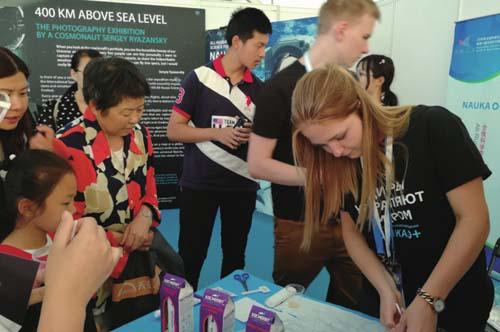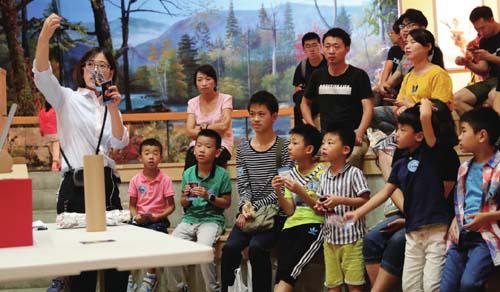Saved by Science
2018-10-31ByWangHairong
By Wang Hairong
The gigantic screen in the hall packed with university students shows an image of Dolly snuggling against her “mother.”Dolly, the most famous sheep in the world, became a celebrity even before she was born as she was the fi rst mammal to be cloned from an adult cell in 1996.
The image leaves viewers puzzled. Why isnt she an exact replica of the adult sheep? Instead, her face is white, while her “mother” is blackfaced. Then British biologist Ian Wilmut, Director of the MRC Center for Regenerative Medicine at the University of Edinburgh, the United Kingdom, steps in to unravel the mystery.
In his presentation on cloning, Wilmut, regarded as Dollys “father” for leading the team that produced the worlds first sheep through asexual reproduction, explains that the difference is due to the fact that the mother is a surrogate and genetically unrelated to Dolly. She actually had three mothers: The egg came from one, the second provided the DNA, and the one showed in the image carried the cloned embryo to term.
Wilmut explained the science behind Dollys birth at the Science Communication Forum, a sub-forum of the World Conference on Science Literacy 2018, held in Beijing in September. Themed Science Literacy for a Shared and Better Future, it was the first such international event in the world, hosted by the China Association for Science and Technology (CAST). Attended by representatives from international organizations, governmental agencies, science communication organizations, as well as universities and research institutes, the conference saw many celebrities from the science, education and business communities in attendance.
Door to progress
The importance of the conference was evident from the high level of attention it received. Chinese President Xi Jinping sent a message, saying science and technology is the primary productive force and innovation a crucial driver behind development. He called science popularization as important as innovation and hoped the participants would contribute to improving science literacy, share scientific achievements and advance building a community with a shared future for humanity.
UN Secretary General Antonio Guterres also sent a congratulatory letter. “Science, technology and innovation are crucial for addressing the challenges of our time, from climate change and food security to healthcare and protecting the planet,” he said. “Science literacy opens the door to progress. As we strive to achieve the Sustainable Development Goals, we must do more not only to harness science for good, but to advance science literacy.”
The Beijing Declaration adopted by the conference also emphasized the importance of science literacy. “Science literacy is an intrinsic requirement for an individuals all-around development, for the social foundation of a nations innovation capacity and sustainable development, as well as for the intellectual foundation of mutual understanding and peace in human society,” it stated.
Tom McLeish, professor of natural philosophy at the University of York, Canada, gave a pragmatic reason for science literacy.“Questions regarding genetically altered foods, nuclear power plants, global warming, fl uoridated water and energy conservation confront us every day,” he said. “Science education can help develop informed citizens who are prepared to deal with science-related social issues and who can infl uence policy that affects them and their communities.”
Chinas overall science literacy level has increased signifi cantly. According to the Report on the Construction of Public Science Literacy in China (2018) released at the conference, it rose from 1.6 percent in 2005 to 8.47 percent in 2018. The rise was higher in Beijing and Shanghai, over 21 percent.
Experiencing science
Li Jiapeng, a primary school student in Caoyuping, a village in north Chinas Shanxi Province, has never been outside the area. It was his long-time wish to see Tiananmen, the historical monument at the heart of Beijing that is a symbol of national unity, but he didnt think his wish would come true. Then one day, a CAST science popularization caravan arrived in the village. It brought virtual reality (VR) headsets that turned viewed objects three-dimensional.The device helped him see the monumental gate as if in reality, as well as learn about the outside world.
As CAST Executive Vice President Huai Jinpeng reviewed Chinas policies and achievements in promoting science literacy with data, stories and photographs during the three-day conference, one image touched the heart. It showed Li standing on a slope overlooking his village. Despite the distance from Beijing, he had bridged the gap with science and was looking at the images he had long wanted to see on his VR headset.
Huai called science popularization caravans mobile science museums for counties and cities without a science museum. On average, every two counties in China have one caravan, while every prefecture-level city has its own science museum. Schools teach science with some classes conducted in science museums. In addition, nearly 30,000 e-stations have been set up in rural schools to spread scientifi c knowledge digitally. Agricultural scientists and technicians are sent to rural areas to improve science literacy and contribute to rural production and poverty alleviation.
The third Saturday of September is Science Popularization Day, when weeklong activities are held to mark the event.
In China, the law also ensures science popularization with the Constitution, the Law on the Popularization of Science and Technology promulgated in 2002, and the Action Plan Outline for Improving Peoples Science Literacy implemented in 2006.
Seeing is believing
Today, popular and even entertaining elements are being harnessed to improve science literacy. Martyn Poliakoff, a research professor of chemistry at the University of Nottingham in the United Kingdom, described how in 2008 his university hired a professional videographer to make short films about science. Separate videos were made about each of the 118 chemical elements in the Periodic Table. Ten years later, they are still making chemistry videos, which are viewed by hundreds of millions of people worldwide.
An international exhibition on the sidelines of the conference with contributions by 14 countries also chipped in to draw visitors, especially children. A 6-year-old primary school student, who identifi ed himself only by his surname Yang, said he spent an entire Sunday at the exhibition. Yang was eagerly munching the space food offered at the All-Russia Festival of Science kiosk.
It is rice and apricot-flavored and tastes sweet, Yang said after eating his portion. There was a long queue at the counter. Beef-fl avored space food was also available, Yang informed.
The South African Radio Astronomy Observatory, which hosts the worlds largest telescope, showed how a group of the most powerful telescopes in the world work. With a VR headset, visitors could have a 360-degree view of the super telescopes on a mountain and hear how they operate.
In yet another kiosk, a white tent beside the Beijing National Stadium, an Olympic venue, Wolfgang Meyer was explaining acid-base neutralization to curious students. The instructor from Bielefeld University, Germany, where he teaches students aged 10-18 how to do chemical experiments, told Beijing Review it was his fourth trip to popularize science in China. Meyer said he enjoys explaining science to Chinese students.
Science teachers like Meyer play an irreplaceable role in giving scientifi c knowledge to young students, Duncan Haldane, winner of the Nobel Prize in physics in 2016, said. “From my own experience, I believe the key to inspiring future scientists usually starts with a committed and enthusiastic science teacher in high school. When I ask colleagues about what got them started on their path, this is the most common answer. This group of teachers is a national treasure in every country,” Haldane said at the conference.
